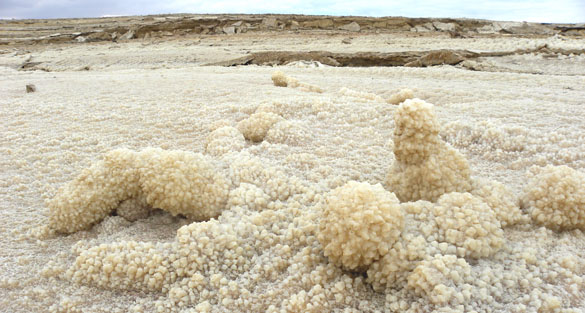 MITZPE RAMON, ISRAEL–Today we saw the Dead Sea in an amazing way. Yoav is working on a project involving the siting of a new pumping station along the western shore of the Dead Sea. We had a preview of a trip he is taking on Monday with a group of government officials to discuss the environmental and geoengineering factors that should be considered during this construction. We were able to go to places rarely visited, and to have an account and analysis by a well-respected expert.
MITZPE RAMON, ISRAEL–Today we saw the Dead Sea in an amazing way. Yoav is working on a project involving the siting of a new pumping station along the western shore of the Dead Sea. We had a preview of a trip he is taking on Monday with a group of government officials to discuss the environmental and geoengineering factors that should be considered during this construction. We were able to go to places rarely visited, and to have an account and analysis by a well-respected expert.
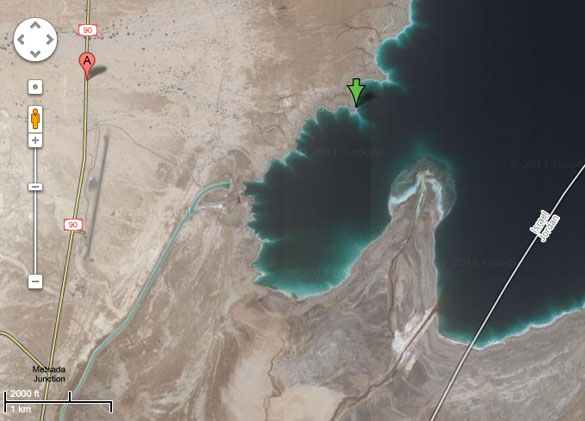 This is a Google Maps view of where we explored the shoreline of the Dead Sea. The green arrow marks our lunch spot (N31.33594°, E35.41427°). Note the thin bluish canal in the lower left running through the scale. The top end of it is where the pumping station sits today. It is pumping water into the southern evaporation ponds to be used in the Dead Sea Works mineral extraction process.
This is a Google Maps view of where we explored the shoreline of the Dead Sea. The green arrow marks our lunch spot (N31.33594°, E35.41427°). Note the thin bluish canal in the lower left running through the scale. The top end of it is where the pumping station sits today. It is pumping water into the southern evaporation ponds to be used in the Dead Sea Works mineral extraction process.
 We walked down an active gully of an alluvial fan to meet the edge of the water. Its deep blue color was striking. The raised brown area in the background consists of dissected Dead Sea bottom sediments. Water levels have been dropping about one meter a year for decades now, leaving vast areas of Dead Sea mud exposed and eroded.
We walked down an active gully of an alluvial fan to meet the edge of the water. Its deep blue color was striking. The raised brown area in the background consists of dissected Dead Sea bottom sediments. Water levels have been dropping about one meter a year for decades now, leaving vast areas of Dead Sea mud exposed and eroded.
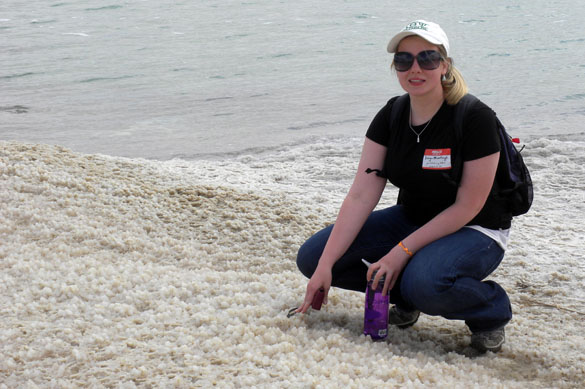 Melissa examining the halite crystals at the edge along the shoreline. It is very thick from the receding water levels and storm waters splashed up on shore, precipitating salt crusts.
Melissa examining the halite crystals at the edge along the shoreline. It is very thick from the receding water levels and storm waters splashed up on shore, precipitating salt crusts.
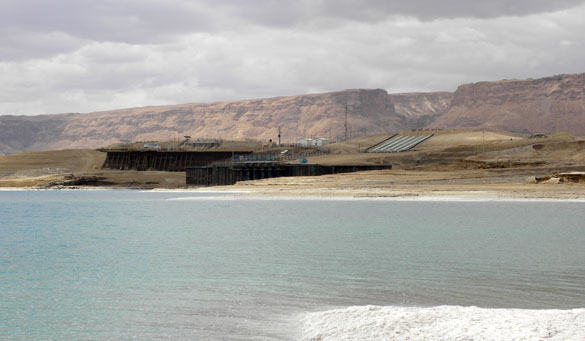 This is the pumping station today. It must be replaced soon because the water levels are dropping rapidly, which will leave its intake systems exposed. This station pumps water to the southern evaporation ponds about three months during the summer. This is when the brines are at maximum concentration. That is Masada, by the way, in the background on the far right.
This is the pumping station today. It must be replaced soon because the water levels are dropping rapidly, which will leave its intake systems exposed. This station pumps water to the southern evaporation ponds about three months during the summer. This is when the brines are at maximum concentration. That is Masada, by the way, in the background on the far right.
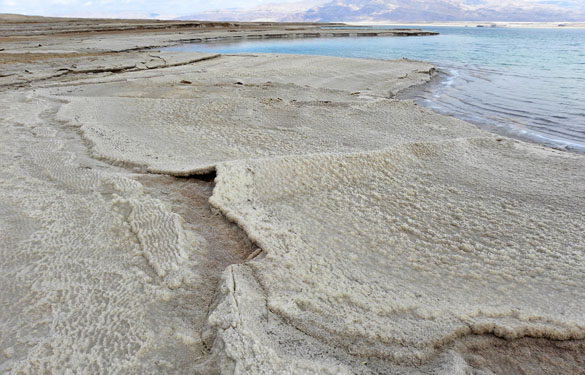 All of us who teach sedimentary geology talk about teepee structures formed when crystallization pressures expand an evaporative mineral sheet until it breaks and bends. Can there be a better example than this?
All of us who teach sedimentary geology talk about teepee structures formed when crystallization pressures expand an evaporative mineral sheet until it breaks and bends. Can there be a better example than this?
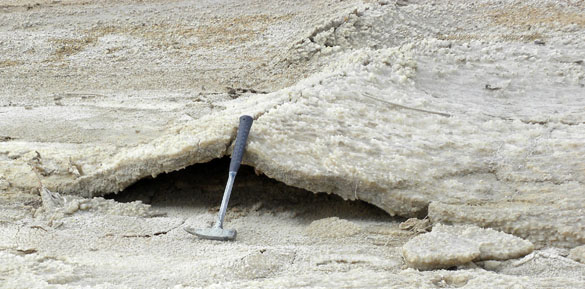 Here is another teepee structure in side view with a hammer for scale. The broken apex is visible at the top of the arch formed by crystals growing with nowhere to expand but up. I’ve seen these in outcrops of ancient evaporative sequences, but never in a recent situation.
Here is another teepee structure in side view with a hammer for scale. The broken apex is visible at the top of the arch formed by crystals growing with nowhere to expand but up. I’ve seen these in outcrops of ancient evaporative sequences, but never in a recent situation.
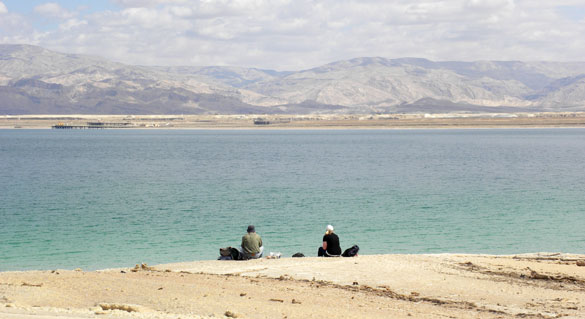 Our lunch stop. We are seated on the salt looking across the Dead Sea at the beautiful mountains of Jordan. A Jordanian pumping station for their own mineral operation is just visible on the opposite shoreline.
Our lunch stop. We are seated on the salt looking across the Dead Sea at the beautiful mountains of Jordan. A Jordanian pumping station for their own mineral operation is just visible on the opposite shoreline.
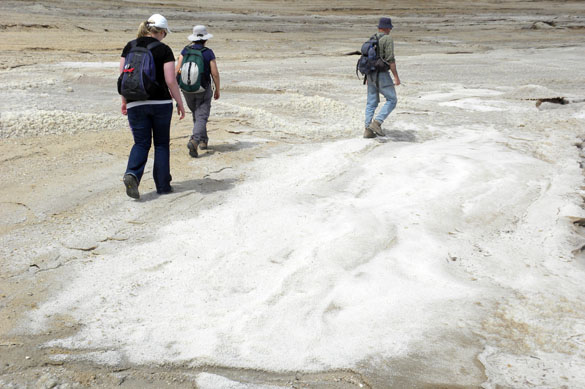 This amazed me. There are small pocket beaches along the shoreline made of rounded grains of salt eroded by the waves of brine. The Dead Sea is forming its own beach sand and granules — all of pure halite.
This amazed me. There are small pocket beaches along the shoreline made of rounded grains of salt eroded by the waves of brine. The Dead Sea is forming its own beach sand and granules — all of pure halite.
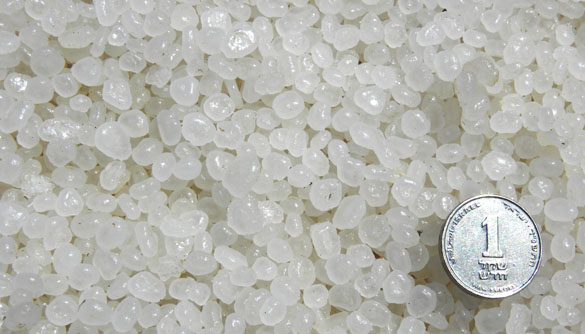 The salt granules are smooth and well sorted by the beach processes. I’d love to bring some of these unique sediment home to Wooster, but the Ohio humidity would destroy it very quickly!
The salt granules are smooth and well sorted by the beach processes. I’d love to bring some of these unique sediment home to Wooster, but the Ohio humidity would destroy it very quickly!
We had a great visit to the Dead Sea today, the lowest spot on land (425 meters below sea level). Yoav gave us an excellent tour of this Land of Salt, and the partly cloudy weather meant we could get good photographs without the usual intense glare of the salt crystals in the sun. We were also as warm and dry as we’ve yet been on this expedition!



Pingback: Stuff we linked to on Twitter last week | Highly Allochthonous
Pingback: AGU Blogosphere - Mountain Beltway - Hanksite and other wonders of Searles Lake
Pingback: Evaporites and the environments in which they form (April 3 & 5) | Sedimentology & Stratigraphy at Wooster
Pingback: Coastal Dead Sea Views from the Israeli Side | Jordan and Jerusalem: A Hales Group Expedition
Pingback: Evaporites and the Environments in Which They Form (April 2 & 4) | Sedimentology & Stratigraphy at Wooster
Pingback: Evaporites and the Environments in Which They Form (March 31 & April 2) | Sedimentology & Stratigraphy at Wooster
Pingback: Evaporites and the Environments in Which They Form (April 5 & 7) | Sedimentology & Stratigraphy at Wooster
Pingback: Evaporites and the Environments in Which They Form (April 4 & 6) | Sedimentology & Stratigraphy at Wooster